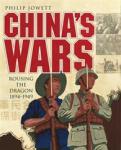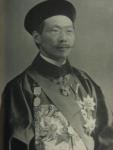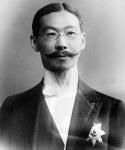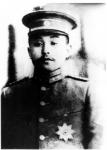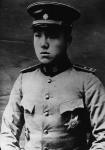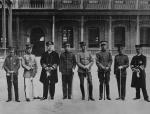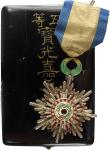-
Posts
851 -
Joined
-
Last visited
-
Days Won
3
Content Type
Profiles
Forums
Blogs
Gallery
Events
Store
Everything posted by drclaw
-

China Early post war Chinese AVG reunion Wings ...
drclaw replied to arrestanddevelopment's topic in China
Very nice, thanks for sharing. If these are numbered, I wonder if they kept a list of recipients. -
Osprey has published a superb new book titled 'China's Wars' which covers the Chinese army from roughly the First Sino-Japanese War to, to the Warlord and Nationalist Period, the Japanese Invasions and the Civil War. It's written by Philip Jowett who many would have come across as author of two excellent Osprey Men-at-War titles on the Chinese Army and the Warlord Period armies. It's a hefty book and provides an excellent and fascinating overview of the period covered. What's most valuable are the wealth of historical photographs contained, including one or two from my own collection My one minor criticism is the continued use of Wade-Giles transliteration for Chinese names and places. I recognise that contemporary Western sources used those form of words at the time, but Hanyu Pinyin has been the accepted international standard since the 1970s/80s not only for China, Taiwan, Singapore, Malaysia, etc, but also by the vast majority of Western scholars. Wade-Giles is quaint but akin to referring to Chinese as 'Chinamen' and the capital of Turkey as 'Constantinople'. Personally I find it frustrating trying to match the words with actual known names and places. But that is a very minor criticism of an otherwise outstanding book. Author: Philip Jowett About this book China is one of the great powers of the modern world. Yet in the late 19th century China was a ramshackle and isolated medieval empire upon whom the European colonial powers could impose their wishes at will. China’s Wars describes the series of conflicts from 1894 to 1949 that forged modern China, from colonial clashes such as the Boxer Rebellion, through the chaotic years of warlord domination to the Japanese invasion, the Second World War and the bitter Civil War that followed.Previously unpublished photographs, contemporary picturesand specially-commissioned maps illustrate these tumultuous events and the men who fought them, events that would end with the eventual triumph of the Communist Party and the rise ofmodern China. Hardback; November 2013; 400 pages; ISBN: 9781782004073
-

Persia - Order of the Lion and the Sun
drclaw replied to drclaw's topic in Middle East & Arab States
Congratulations on your Pouteau Lion, Markus! It certainly is a rare specimen. And the craftsmanship is superb. Interesting the similarity of the lion painting with the Kretly examples. I wonder if the depiction of a lion with a tall elongated head was a popular style of the time not limited to medals. I could easily see it as an Art Nouveau statuette or even an Arthur Rackham illustration. -
Thanks for alerting fellow collectors Bob and sorry to hear about your experiences. I run a mile away from any ebay or non-ebay seller that insists on any form of payment OTHER THAN Paypal, e.g. wire transfer, etc. Exception being reputable auction houses. There was another scam seller purportedly based in the Ukraine advertising rare Manchukuo orders using images culled from somewhere else. Demanded wire-transfer only. In your experience, do many ebay sellers insist on non-Paypal? I recall Ebay was insisting on Paypal but there was some anti-competitive trade practices issues involve. I can now appreciate their reasons for doing so.
-
It's stamped with #1 on the reverse. A truly extraordinary piece! Very different to the enamelled, cross-shaped Merit awards issued by the Ministry of Justice, Treasury, etc.
-
Thanks Pieter, well spotted. That solves that little mystery of the dating of the photo. Another interesting fact. Lu Zhangxiang's mentor Ambassador Ju Jingcheng, a fellow Catholic, submitted a memorial to the Qing Court in 1896 suggesting minor changes to the award categories / criteria for the Double Dragon. Four years later, he and four other senior officials were executed by the Empress Dowager in August 1900 for urging the Court to stop the attacks on the foreigners. According to trusty Wiki, Ju Jingcheng took an interest in Lu when the latter was posted to St Petersburg in 1893 - where Ju was Minister - as an Interpreter (fourth class). Here's a photo of Ju.
-
Ah, where to begin .... Listed for years for $15,000 with no takers. Appeared at a US auction where it did not even make the opening bid at ~ $8000 Re-listed for $17,000 It is advertised as a SECOND Class Second Grade star. But is such a strange fantastic amalgam that throws up so many questions: * The blue enamel is for a THIRD Class neck badge * The Manchu characters near the 7 o'clock or 8 o'clock position state it is a THIRD Class badge * The top red coral stone is an obvious replacement - it barely fits in the hole * The large red coral stone is polished smooth like the FIRST Class stars. It should be blue glass for a Third Class. Or coral engraved with the shou longevity symbol if masquerading as a Second Class. Then, as Nick points out, there's the unusual screw back and absence of makers' marks if it was a Russian or European piece. Most Second Type Double Dragons were Chinese manufactured and I've not encountered one with a Chinese makers' mark (occasionally, a First Type Double Dragon has a Chinese makers mark). For European/Russian made Double Dragons, these TYPICALLY have a makers mark. So who knows how this strange chimera came about. Is it a jewellery conversion? An original with lots of replacement parts? A non-standard but original piece? Third Class badges do appear from time to time with the red centre coral stone of a Second Class badge. If the coral was engraved, one MIGHT theorise that it was possibly awarded as that - who knows, the factory ran out of Second Type insignia that day, the recipient preferred the 'prettier' Third Class badge with the blue enamel because it matched the colour of his eyes ... My money is that it is a curiosity piece at best.
-
A stunning image of an individual wearing Qing robes together with the Double Dragon. Also another of the same individual in Western dress. Lu Zhengxiang wearing a Second Type, Second Class, First Grade breast star. Lu Zhengxiang (1871-1949) was a Qing diplomat whose reformist mentor Xu Jingcheng was executed by the Imperial court during the Boxer Rebellion. He was a Roman Catholic like his mentor and never forgave the Manchu court. When the 1911 Revolution broke out, he was Ambassador in St Petersburg and took it upon himself to cable Beijing that the Western Powers would not intervene on the side of the Dynasty. This added considerable strength to the revolution. Lu later served twice as Premier of the Republic of China before becoming a Benedictine monk and priest in Belgium where he died. The image with the Qing robes is dated The Hague 1906. This is interesting in two ways. Lu was the Qing delegate to the Hague Convention but only in 1907. It also predates the 1908 date that is the consensus date for when the Double Dragon was extended to Chinese citizens.
-
Qing General Wu Luzhen, wearing a Second Type, Second Class breast star. Wu Luzhen studied in Japan as an army cadet before secretly returning to China to lead a failed rebellion in 1900 to restore the Guangxu Emperor to power. In later years, he held various military positions before gaining command of the 6th Division of the Manchu Field Army in 1910. During the 1911 Wuchang Uprising, Wu Luzhen planned to join the Rebellion by leading the 6th Division to Hubei Province. However, he and two of his staff were assassinated by his chief bodyguard Ma Buzhou, reputedly on the orders of Yuan Shikai.
-
Prince Zaitao, brother of the regent Prince Chun and uncle of Emperor Puyi, wearing the Second Type, First Class, Second Grade Order of the Double Dragon and the Imperial Nobility Badge. Zaitao enjoyed a long and distinguished career that encompassed the Guangxu era, the Xuantong Emperor and post-Imperial China. He served the Nationalist Government and was appointed a member of the National People’s Congress after the establishment of the People’s Republic of China in 1949. An accomplished Beijing Opera performer and martial artist, he died in Beijing in 1970 at the age of 82
-
The Order of the Double Dragon was instituted in 1882 as an award exclusive to foreigners. Sir Robert Hart, who designed the order, pushed for it to be extended to Chinese citizens. In 1886, he wrote in a letter: "I am also going to get it suggested to the [Zongli] Yamen that, in order to make the [Double Dragon] better known and give it standing abroad as a Chinese decoration it would do well to cause each Chinese Minister abroad to wear it!". Given the entrenched conservatism of the Qing court, his advice was not acted upon for over 20 years. The accepted view is that the Double Dragon was extended to Chinese citizens in August 1908. In his excellent 2002 JOMSA article, King Kwok referred to the Qing decrees that it was intended that awards be restricted to Chinese diplomats abroad and to local officials responsible for managing foreign affairs. Court records however indicated that the award to Chinese citizens was not limited to these two categories. Chinese recipients included for example Manchu princes; officials in charge of the Army Department and the Agriculture, Industry and Commerce Department; the Admiral of the Imperial Fleet Duan Fang; and the Captain of the Cruiser Hai Qi, the most powerful warship in the Imperial Fleet after the Sino-Japanese War in 1894. Unlike the awards of the Early Republic, the Double Dragon was very sparingly conferred on Chinese citizens - only on Manchu princes and senior officials. Photographs of Chinese recipients are therefore rare. Here are the images I've managed to find. First, Manchu princes resign en-masse after the Revolution. Princes Zaixun (third left) and Zaitao (fifth left) were brothers of the regent and uncles of Emperor Puyi. Both received Ministerial posts in the reorganised Imperial Cabinet of April 1911, which included eight Manchu princes, one Mongol and just four Han to the fury of the Han Chinese that made up over 90 per cent of the population. Prince Zaixun was appointed China’s first Minister of the Navy in December 1910 and is seen wearing the uniform of an admiral. Zaixun and Zaitao received the First Class, Second Grade Double Dragon in 1909 and four of the princes are wearing Double Dragon insignia. The individual on the far left is wearing the five-petal neck badge of the Second Class. He appears to be Yinchang, who was Minister for War. He was a senior Manchu but not a Prince which explains why he is wearing the Second Class and not the First. Four are also wearing the Imperial Nobility Badge introduced in 1909. That insignia was later adopted by the Republic as the Order of Rank and Merit in 1913
-
Thanks! That IS interesting. The Reformed Government predated Wang Jingwei's Reorganised Government. I thought the Warlord period colours looked a little anachronistic for a Wang Jingwei award - they were very careful to follow the Guomindang colours since they claimed to be the legitimate Guomindang government.
-
Very interesting Nick! And not often you come across a case with the design of the medal imprinted on it. Have you come across this award previously?
-
Well this has appeared again, correctly labelled this time - Biyun Temple decoration. Was intrigued by this particular specimen when it was unsold at 1000 euros. Starting price - 4000 euros. http://coins-la-galerie-numismatique.com/auction-xx/china/bi-yun-temple-award It appears to be a sash badge. I've not seen any images of a breast star and it's still a mystery why a Temple would be handing out decorations.
-
Alas no. I don't recall it being sold so it could well turn up again in the near future.
-
Back in 2011, I was contemplating a cased 1st Class set being offered by an Italian auction house. The lacquer case and inscriptions were well kept as was the original sash. It would have been a superb set but for one minor detail - the red enamel of the star looked like a LUNAR LANDSCAPE! It was pitted and crumbling with white spots covering its entire surface. While enamel rot is frequently encountered with the Nanjing Puppet Government awards, it's not something you'd expect for Kyoto Mint insignia. But evidently this can happen. Who knows what the unique conditions causing it were - bad batch of enamels, incorrect curing process, set stored in a damp cellar the last 60 years ...
-
If this was a stamp it would be worth 10 times the value This is one of the nicer looking Yong zeng tigers. Some of the Yong zeng tigers look downright cartoony.
-
Great pictures Nick! There was a touch of cultural cringe in that long after Europeans abandoned them, the Japanese still insisted on wearing top hats, cocked hats and waist coats. I believe in Tokyo, ambassadors presenting their credentials still get driven to the palace in a Disney land style horse drawn carriage!
-
A fine 5th Class in its presentation case. It appears to be missing the four screw heads on the reverse? This was recently auctioned by Carsten Zeige for 3500 Euros excl. buyers' premium. http://www.zeige.com/en/index2.html http://gmic.co.uk/uploads/monthly_09_2013/post-11630-0-99535500-1379803070.jpghttp://gmic.co.uk/uploads/monthly_09_2013/post-11630-0-40231600-1379803105.jpghttp://gmic.co.uk/uploads/monthly_09_2013/post-11630-0-25418900-1379803139.jpg
-
Thanks for this Nick. These come up from time to time but I've never seen a cased one before. Particularly interesting is the makers mark on the inner lid of the case. It's a Sacred Tripod! Pity the characters are indistinct. The quality is also superior to what you might expect for a regional warlord issue.
-
Jean-Sam, these medals look like they're in superb condition. Did they all belong to the same recipient / collection?
-
Hi Dave, Ed Hayne's article on the awards of the PRC in the March-April 2013 JOMSA has a brief reference. See page 36. Other than that, there's very little published material (outside China) on PRC awards and Chinese awards in general.
-
Yes, the size is certainly what grabs you. You can appreciate why Westerners at the time uncharitably described them as "cow bells and dinner plates" and weren't enamoured about wearing them. I'd wager that one single medal is worth more today than all those other medals on General Gallieni's chest.
-

Persia - Order of the Lion and the Sun
drclaw replied to drclaw's topic in Middle East & Arab States
Beautiful Markus! The colours of the centre medallion portrait are vibrantly rich and definitely European. Hard to imagine that this is over 150 years old. -
Great photos Nick! Markus - Re. your post #74. The star corpus looks very similar in style to those of the Order of the Garter so if I had to guess, I'd say English.


